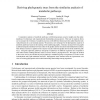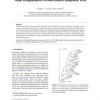BMCBI
2010
13 years 4 months ago
2010
Background: Co-evolution is the process in which two (or more) sets of orthologs exhibit a similar or correlative pattern of evolution. Co-evolution is a powerful way to learn abo...
BIOINFORMATICS
2010
13 years 4 months ago
2010
Phylogenetic trees are widely used to display estimates of how groups of species evolved. Each phylogenetic tree can be seen as a collection of clusters, subgroups of the species ...
ALMOB
2007
13 years 4 months ago
2007
Background: Neighbor-Net is a novel method for phylogenetic analysis that is currently being widely used in areas such as virology, bacteriology, and plant evolution. Given an inp...
ISMB
2003
13 years 6 months ago
2003
Comparative analysis of metabolic pathways in different genomes can give insights into the understanding of evolutionary and organizational relationships among species. This type ...
VISSYM
2004
13 years 6 months ago
2004
Phylogenetic trees are built by examining differences in the biological traits of a set of species. An example of such a trait is a biological network such as a metabolic pathway,...
ISBRA
2010
Springer
13 years 8 months ago
2010
Springer
Abstract. Phylogenetic trees are tree structures that depict relationships between organisms. Popular analysis techniques often produce large collections of candidate trees, which ...
CSB
2004
IEEE
13 years 8 months ago
2004
IEEE
Phylogenetic trees are commonly reconstructed based on hard optimization problems such as maximum parsimony (MP) and maximum likelihood (ML). Conventional MP heuristics for produc...
LPNMR
2009
Springer
13 years 9 months ago
2009
Springer
This note summarizes the use of Answer Set Programming to solve various computational problems to infer phylogenetic trees and phylogenetic networks, and discusses its applicabilit...
WABI
2004
Springer
13 years 10 months ago
2004
Springer
Computational heuristics are the primary methods for reconstruction of phylogenetic trees on large datasets. Most large-scale phylogenetic analyses produce numerous trees that are ...
WABI
2005
Springer
13 years 10 months ago
2005
Springer
Phylogenetic tree searching algorithms often produce thousands of trees which biologists save in Newick format in order to perform further analysis. Unfortunately, Newick is neithe...




